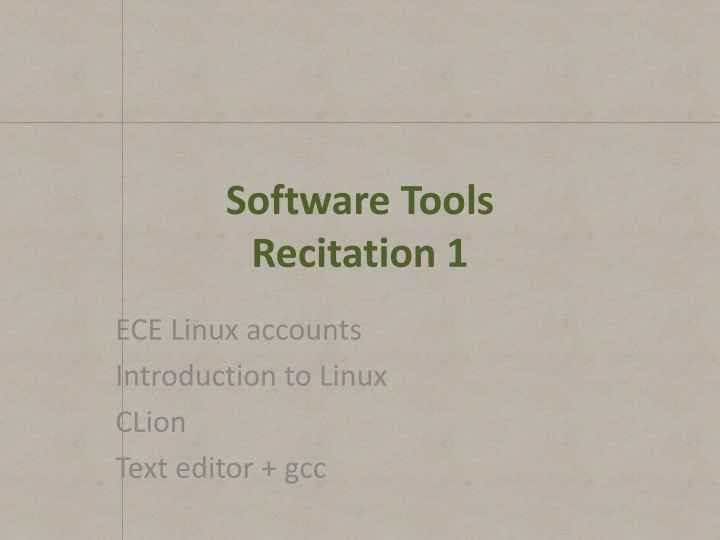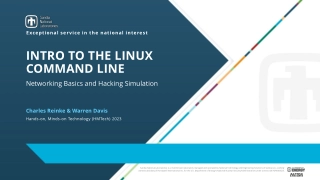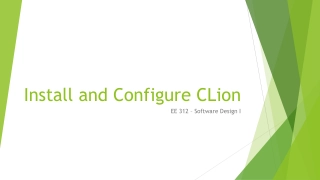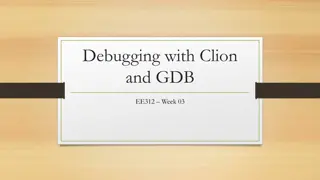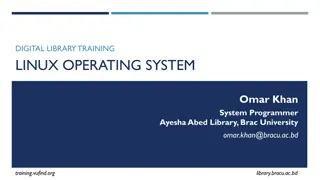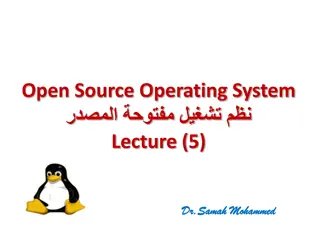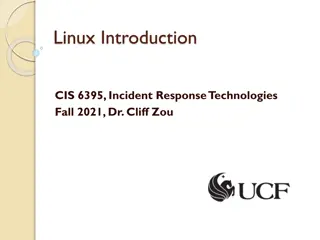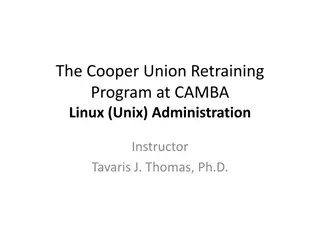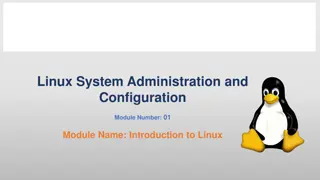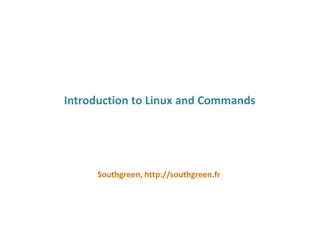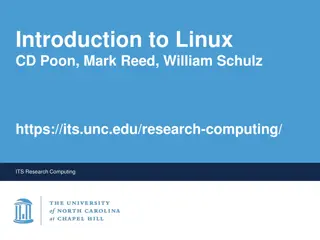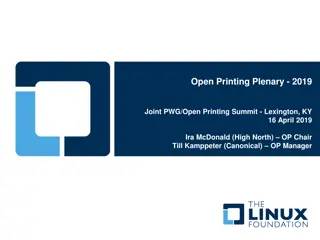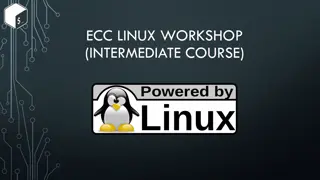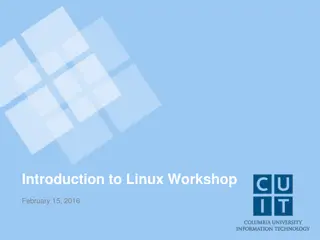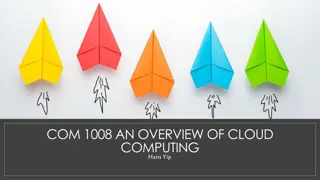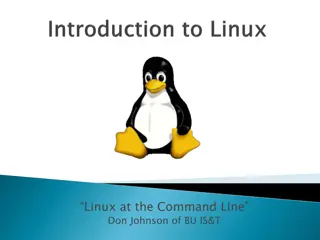Introduction to ECE Linux Accounts and CLion IDE
This content provides a guide to enabling your ECE Linux account, testing projects on 64-bit ECE Linux machines, and using CLion IDE for C and C++ development. It includes instructions on connecting via SSH, setting up projects in CLion, and creating a new project with specific requirements. Explore Linux account setup, project testing, and CLion IDE usage in this comprehensive tutorial.
Uploaded on Feb 23, 2025 | 0 Views
Download Presentation

Please find below an Image/Link to download the presentation.
The content on the website is provided AS IS for your information and personal use only. It may not be sold, licensed, or shared on other websites without obtaining consent from the author.If you encounter any issues during the download, it is possible that the publisher has removed the file from their server.
You are allowed to download the files provided on this website for personal or commercial use, subject to the condition that they are used lawfully. All files are the property of their respective owners.
The content on the website is provided AS IS for your information and personal use only. It may not be sold, licensed, or shared on other websites without obtaining consent from the author.
E N D
Presentation Transcript
Software Tools Recitation 1 ECE Linux accounts Introduction to Linux CLion Text editor + gcc
ECE Linux Account Enable your account We will grade your projects on the 64-bit ECE Linux machines Test your project on those machines (e.g., kamek) before you submit for grading Using Windows? Connect with Putty Use ssh to log in to Linux machine Using Mac OS (10.7 and above)? You'll need XQuartz Try it: ssh X username@kamek.ece.utexas.edu You will be prompted for your password
CLion: Integrated Development Environment C and C++ Recommended IDE for EE 312 Apply for an academic license Download and installation Quick Start system requirements Creating a project
CLion Create a new project, open an existing project, or check out from version control (e.g., git)
CLion: creating a new C project Menu File|New Project|C Executable Enter a name for your project (default is untitled) Choose language standard: C11 Project initially contains only file main.c Change file name using menu Refactor|move Add new files (.c or .h) to project: Menu View|Tool Windows|Project In Project window, right-click directory for new file Select New from menu Select C/C++ Source File (.c) or C/C++ Header File (.h) Add new file to SOURCE_FILES in CMakeLists.txt
CLion Exercise Create a new project called Recitation1 In this project, create a new .c file called stuff.c Edit stuff.c so that when you select "build all", it prints the message, "My name is Inigo Montoya, you killed my father, prepare to die!" (without the quotes) Run it!
Text Editor: emacs You can use emacs on your Mac or Windows machine From linux prompt on kamek (or yoshi, mario, ...): % emacs & C-x C-f: create a new file called helloWorld.c Enter your program C-x C-s: saves your file C-x C-c: exit emacs % gcc o helloWorld helloWorld.c % ./helloWorld Emacs tutorial: C-h t
Debugging with gdb Download this program, arrayMax.c Compile with the g option to embed debugging info: gcc std=c99 g o arrayMax arrayMax.c Execute: ./arrayMax Oops! Seg fault (core dumped) Start gdb on the executable file: gdb arrayMax List your program with l or list: (gdb) l Set some breakpoints (b linenumber or b functionName) and step through until you identify the problem. List of gdb commands on next slide...
gdb: command line debugger Useful commands break linenumber create breakpoint at specified line run run program c continue execution step execute next line or step into function quit quit gdb print expression print current value of expression l list program
Introduction to Linux "UNIX IS BASICALLY A SIMPLE OPERATING SYSTEM, BUT YOU HAVE TO BE A GENIUS TO UNDERSTAND THE SIMPLICITY." -- DENNIS RITCHIE, CREATOR OF C PROGRAMMING LANGUAGE
Tux, the Linux mascot Some History 1969: Unix operating system, Ken Thompson and Dennis Ritchie Unix widely adopted 1977: Berkeley Software Distribution (BSD) by UC Berkeley 1983: GNU project by Richard Stallman free Unix-like OS (GPL). 1991: Undergrad Linus Torvalds' fun project that became Linux kernel Image:lewing@isc.tamu.edu Larry Ewing and The GIMP
Linux Operating System Open source Built-in networking Rich software development environment Powerful, flexible command-line interface (CLI)
Unix/Linux shell program that takes Unix commands from keyboard and executes them sh: Bourne shell bash: Bourne Again shell csh: C-shell We are using this Hierarchical File system home directory: where you are in your file system when you log in contains all your files directories contain subdirectories & files file system looks like a tree of directories & files https://commons.wikimedia.org/w/index.php?title=File:Chdir_example.png&oldid=141616172
cd: change directory cd subDirName: move to a subdirectory of your current directory Example: I'm currently in my home directory (denoted ~). To move into ee312 subdirectory: % cd ee312 To move to this directory from any directory: % cd ~/ee312 To move to parent directory, one level up in the directory tree: % cd .. parent directory referred to as ..
mkdir: create directory To create a subdirectory called ee312 in current directory: % mkdir ee312 To move into the ee312 directory and create a project1 directory: %cd ee312 %mkdir project1
pwd: where am I? To see the directory you are currently in: % pwd /Users/eberlein/EE312
Exercise Connect to one of the ECE linux machines Use pwd to display your current directory (which is your home directory) Create an EE312 directory in home directory Create a project1 subdirectory in your EE312 directory
list, remove and copy files ls: list files in current directory rm fileName: remove specified file cp file1 file2: Make a copy of file1 named file2 Example: % pwd /Users/eberlein/Documents/EE312 % ls lab1 lab2 project1 lab2 topic1.pptx lab1Notes.txt % rm topic1.pptx % cp lab1Notes.txt lab1NotesCopy.txt % ls lab1 lab2 project1 lab2 lab1Notes.txt lab1NotesCopy.txt
mv:renaming files mv file1 file2: move file1 to file2 (file1 is renamed file2) mv file1 dir: move file1 to directory dir Example: Move lab1Notes.txt to parent directory % mv lab1Notes.txt ..
more: display contents of file more file1.txt: displays contents of file1.txt, one screen at a time hit space bar to see next screen of contents Pipe the output of one command as input to another command using | To list files in directory, one screen at a time: % ls|more
Output Redirection > file append to command that writes to standard output output of command written to file Example: who: Unix command displays list of users who are currently logged on to computer Try this: % who % who > peeps % more peeps more: displays file contents
Input Redirection < file Append to command that takes input from standard input Input taken from file instead Example: Use a text editor to create a program that reads two integers from standard input and prints their sum (store program in sum.c) Create text file input.txt containing: 2 3 Try this: % gcc o hello hello.c % ./hello < input.txt Sum is 5 #include<stdio.h> int main() { int value1, value2; int sum; scanf(" %d %d", &value1, &value2); sum = value1 + value2; printf("Sum is %d\n", sum); }
Exercise Using the executable hello from the previous example, run the program read input from input.txt write output to a new file output.txt
man: Online Help man command: see the manual page, which provides online info on any Unix command Example: Get a description of the ls command bash$ man ls
Unix/Linux Tutorials ECE tutorial Unix tutorial from the Berkeley I-School
